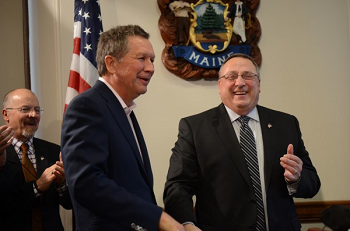
Ohio Governor John Kasich isn’t afraid of controversy, and he’s been taking his show on the road as of late. In Maine recently, he promoted a constitutional convention to force a balanced budget amendment. But the LePage Administration isn’t promoting Governor Kasich’s other controversial, more successful stand: Kasich bucked his party and championed accepting federal health care funds to cover the working poor in Ohio – and he continues to do so.
Earlier this winter, Governor Kasich visited Montana, too. He was frank with legislators, telling them that rejecting Medicaid “on an ideological basis, when people can lose their lives because they get no help, doesn’t make a lot of sense to me.” Despite dire predictions from ideologues and out-of-state think tanks when Kasich signed the bill, expanding Medicaid continues to make a lot of sense for Ohio.
First, Ohio saved money by accepting the federal funds, even though more people qualified for expanded Medicaid in Ohio than Ohio State researchers anticipated. Overall, Ohio’s Medicaid enrollments are down by 145,000 from original projections – but federal healthcare dollars cover 100% of costs for the larger proportion of new enrollees in expanded Medicaid, instead of the lower match rate under traditional Medicaid. Largely because health reform funds cover 100% of the new enrollees’ monthly costs, rather than the 37 cents on the dollar paid under traditional Medicaid, the state saved $470 million over the two-year budget. Governor Kasich also took this opportunity to reform Ohio Medicaid, placing new beneficiaries in a managed care plan, linking pay to provider performance, and working to help more elderly and disabled stay in their homes or communities, rather than nursing homes.
Second, healthcare job growth accelerated in Ohio. Seven thousand new healthcare and social assistance jobs were created statewide in the first full year of Medicaid expansion. Ohio hospitals and community health clinics also report decreases in the number of uninsured they serve and in the amount of uncompensated “free” care they provide.
Last – but most important, as Governor Kasich has emphasized in many forums – more Ohioans have access to healthcare. According to the Governor’s Office of Health Transformation, 75 percent of Ohio’s uninsured population is working. “Connecting them to coverage means keeping them in jobs,” concludes the Office’s report on expansion. As Gov. Kasich predicted, Ohio is also making progress with drug addiction. One county sheriff testified that now, instead of diverting treatment dollars to keep people in jail, local drug treatment staff matches inmates with services to continue treating them upon their release.
Governor Kasich is no stranger to the kind of press coverage he received in Maine. He faced hard questions about his Medicaid stance at the Republican Governor’s Conference this fall. He penned a June 2013 op-ed in USA Today on Medicaid expansion, noting that President Reagan expanded Medicaid several times. He has been unafraid to engage with outlets from Fox News to The New York Times, telling radio host Laura Ingraham: “And I think that it’s critical that [the federal government] are able to help people to help themselves get them to work. Now, we promised the mentally ill when we took them out of the big institutions that they would get help. Where are they now? We have ten thousand in our prisons, many in the jails and many on the streets. Conservatism means that you help people so they can help themselves and that they can enter into the economic strength of our country.”
Too bad Gov. LePage didn’t follow Gov. Kasich’s lead on Medicaid expansion; tens of thousands of Mainers would now have health care, thousands would have new jobs, and our economy would benefit from a half-billion dollars annually in federal funding.


